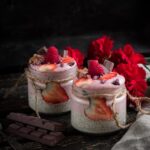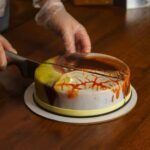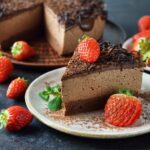Whipped cream icing is a game-changer for cake decorators, offering a world of possibilities when it comes to creating stunning cake designs. Its versatility and elegance make it a popular choice among both professionals and DIY enthusiasts. With whipped cream icing, you can explore a wide range of designs and effects that will impress your guests and elevate your cake decorating game.
The key to successful whipped cream icing lies in understanding the basics. Before diving into the world of elaborate cake decorations, it is essential to grasp the ingredients and tools needed for whipped cream icing. Additionally, knowing the difference between stabilized and non-stabilized whipped cream will help you achieve the desired consistency and longevity for your designs.
To ensure success with whipped cream icing, mastering the art of achieving perfect peaks and consistency is crucial. This section will provide you with valuable tips and tricks to avoid common pitfalls and challenges while working with this delicate yet delightful icing technique. Whether you’re a beginner or an experienced decorator, there’s always something new to learn when it comes to working with whipped cream.
In the following sections, we will dive deeper into different flavors and variations of whipped cream icing, step-by-step guides for creating beautiful designs, decorating techniques, using fresh fruits and berries alongside whipped cream, as well as showcasing stunning ideas for special occasions like weddings and birthdays. By the end of this article, you’ll be equipped with all the knowledge needed to take your cake decorating skills to new heights with the versatile addition of whipped cream icing.
Understanding the Basics of Whipped Cream Icing
Ingredients and Tools
Whipped cream icing is a delightful addition to any cake, bringing a light and airy texture that perfectly complements the sweetness of the cake itself. To achieve this delectable icing, you will need a few basic ingredients. The main component is, of course, heavy whipping cream. Make sure to use cold cream straight from the refrigerator for the best results. You will also need some confectioners’ sugar to sweeten the whipped cream and stabilize it.
While the ingredients are relatively simple, there are a few tools that will make your whipped cream icing preparation much easier. A stand mixer or hand mixer is essential for whisking the cream until it reaches stiff peaks. Additionally, a large mixing bowl with high sides will prevent splattering as you whip the cream at high speeds.
Stabilized vs Non-Stabilized Whipped Cream
When it comes to whipped cream icing, one important distinction to understand is the difference between stabilized and non-stabilized whipped cream. Stabilized whipped cream has an added ingredient that helps it maintain its shape and hold up better over time.
To stabilize your whipped cream, you can add gelatin or cornstarch to help prevent it from deflating or weeping. Gelatin acts as a setting agent while cornstarch helps absorb excess liquid. Stabilizing your whipped cream is particularly useful if you plan on piping intricate designs or if you need your cake to hold up for an extended period.
On the other hand, non-stabilized whipped cream should be used immediately after whipping and works best when serving desserts right away. It has a lighter and more delicate texture compared to stabilized whipped cream but may not hold its shape for long periods.
Understanding these basics of whipped cream icing will set you up for success as you dive into creating beautiful designs for your cakes and pastries. With just a few ingredients and the right tools, you’ll be well on your way to mastering this elegant icing technique.
Tips and Tricks for Successful Whipped Cream Icing
Mastering the Art of Achieving Perfect Peaks and Consistency
When it comes to whipped cream icing, achieving the right consistency is key. The goal is to whip the cream until it forms stiff peaks that can hold their shape, but be careful not to overmix, as this can result in butter. To master this technique, begin by chilling the bowl and beaters or whisk attachment in the refrigerator for about 15 minutes. Cold equipment helps keep the cream cool and encourages quicker whipping.
Start by using chilled heavy whipping cream with a high fat content, usually around 35%. Pour the cream into the cold bowl and begin beating it slowly, gradually increasing the speed to medium-high.
As you see soft peaks start to form – meaning the cream holds its shape for a few seconds before gently collapsing – add your desired sweetener (sugar or confectioners’ sugar) and flavorings (vanilla extract or other extracts). Continue beating until stiff peaks form – when the peaks stand upright without collapsing.
How to Avoid Common Pitfalls and Challenges
Working with whipped cream icing presents some challenges that could compromise your cake decorating efforts if not properly addressed. Here are a few tips to help you navigate potential pitfalls:
- Avoid underwhipping: Underwhipped cream will have a runny consistency and won’t hold its shape when piped onto a cake. Make sure to beat until stiff peaks form for optimal results.
- Prevent overwhipping: Be cautious not to overbeat your whipped cream, as it could result in curdling and eventually turning into butter. Keep a close eye on your mixer or use manual hand whisking towards the end to have more control over consistency.
- Keep everything cool: Whipped cream is sensitive to heat, so ensure all ingredients and equipment are chilled before starting. If necessary, work in a cool environment or refrigerate the cake as needed during the decorating process.
- Stabilize your whipped cream: If you plan to decorate a cake in advance or want your whipped cream to hold its shape for longer, consider stabilizing it with gelatin, cream cheese, or other stabilizers. This will help prevent any sagging or melting of your design.
With these tips and tricks in mind, you’ll be well on your way to achieving successful whipped cream icing every time. Remember, practice makes perfect, so don’t be discouraged if it takes a few attempts to master the technique. Enjoy the journey and let your creativity shine through.
Exploring Different Flavors and Variations of Whipped Cream Icing
Whipped cream icing is not just limited to its classic vanilla flavor. By incorporating different flavors and variations, cake decorators can add an exciting twist to their repertoire and create unique and delicious creations. The possibilities are endless when it comes to experimenting with flavors in whipped cream icing, whether you want to elevate the taste or match it with the cake’s theme or occasion.
One popular variation of whipped cream icing is chocolate whipped cream. Adding cocoa powder or melted chocolate to the mixture intensifies the flavor and creates a rich and decadent frosting that pairs well with chocolate cakes or as a filling for macarons or pastries. Citrus flavors, such as lemon or orange zest, can also be infused into whipped cream icing for a refreshing taste that complements fruity or light-flavored cakes.
Coffee lovers can rejoice as coffee-infused whipped cream icing brings a delightful caffeinated twist to any dessert. By adding instant coffee granules or espresso powder, you can achieve a subtle coffee flavor that is perfect for pairing with chocolate cakes or creating mocha-inspired designs.
To add visual appeal to your whipped cream designs, consider experimenting with colored whipped cream. Using food coloring gels, you can achieve vibrant hues that enhance the overall look of your creations. Whether it’s pastel shades for a whimsical cake design or bold colors for a statement piece, colored whipped cream opens up endless possibilities for creative decorations.
| Flavor/Variation | Description |
|---|---|
| Chocolate Whipped Cream | A rich and indulgent variation with cocoa powder or melted chocolate added. |
| Citrus Whipped Cream | A refreshing citrus twist with the addition of lemon or orange zest. |
| Coffee Whipped Cream | A delightful and caffeinated variation with instant coffee granules or espresso powder. |
| Colored Whipped Cream | Using food coloring gels to achieve vibrant and eye-catching colors. |
By exploring different flavors and experimenting with variations, cake decorators can truly elevate their whipped cream icing creations. Whether you prefer classic chocolate, zesty citrus, or a coffee kick, these flavor additions will not only enhance the taste but also expand your creative possibilities. Don’t be afraid to think outside the box and create unique combinations that will leave your guests impressed with both the look and taste of your cakes.
Step-by-Step Guide to Creating Beautiful Whipped Cream Designs
Whipped cream icing is not only delicious, but it also offers endless possibilities for creating beautiful designs on cakes. In this section, we will provide a step-by-step guide to help you master the art of creating stunning whipped cream designs. Whether you are a beginner or an experienced cake decorator, these tips and techniques will help you achieve professional-looking finishes.
Step 1: Prepare the whipped cream
- Start by chilling your mixing bowl and beaters in the refrigerator for about 15 minutes.
- Pour cold heavy whipping cream into the chilled bowl and beat it on medium speed until soft peaks form.
- Add powdered sugar and vanilla extract (or any other desired flavorings) to enhance the taste of the whipped cream. Continue beating until stiff peaks form.
Step 2: Choose your piping tip
- Select a piping tip that complements your design idea. Different tips create different effects, so consider using a star tip for rosettes or swirls, a round tip for borders or lettering, and a petal tip for more intricate patterns.
- Attach the piping tip to a piping bag, making sure it is securely fitted.
Step 3: Fill the piping bag
- Spoon the whipped cream into the prepared piping bag. To avoid air bubbles, gently tap the bag on a flat surface to remove any trapped pockets of air.
- Twist the top of the bag to prevent the whipped cream from escaping while you pipe.
Step 4: Practice your technique
- Before piping directly onto your cake, practice your technique on a piece of parchment paper or a plate. This will help you get comfortable with controlling the pressure and movement of the bag to achieve consistent results.
Step 5: Start decorating
- Hold the piping bag at approximately a 90-degree angle above your cake surface.
- Apply gentle pressure to squeeze out the whipped cream while guiding it in desired patterns or shapes.
- For borders or lettering, apply steady pressure while moving the bag in a consistent motion.
- For rosettes or swirls, start at the center and pipe in a circular motion, gradually moving outward.
Step 6: Finishing touches
- Once you have completed your design, you can add additional embellishments such as sprinkles, edible pearls, or fresh fruits to enhance the overall presentation of your cake.
Remember that practice makes perfect when it comes to creating whipped cream designs. Don’t be discouraged if your first attempts are not exactly what you envisioned. With time and practice, you will develop your own unique style and technique. So, grab your piping bag and get ready to impress with your beautifully decorated cakes using whipped cream icing.
Decorating Techniques
When it comes to cake decorating, few things are as visually appealing and delicious as the combination of whipped cream icing and fresh fruits or berries. The light and airy texture of whipped cream perfectly complements the natural sweetness of ripe fruits, creating a harmonious balance that is sure to impress both the eyes and taste buds.
In this section, we will explore various techniques that showcase how whipped cream icing can be paired with fresh fruits and berries to elevate your cake designs.
One technique that works exceptionally well with whipped cream icing is macerating fruits. Maceration involves marinating sliced or diced fruits in sugar or syrup, which not only adds sweetness but also helps soften their texture. When you incorporate these macerated fruits into your cake layers or fillings, they infuse the entire dessert with their juicy flavors while adding a delightful contrast in texture to the creamy frosting.
Another approach to incorporating fresh fruits is by creating fruit-filled layers within your cake. This involves slicing the cake horizontally into multiple layers and spreading a generous amount of whipped cream icing mixed with fresh fruits between each layer. The result is a stunning display of colorful fruit-filled layers when the cake is cut, providing both a visual treat and bursts of fruity goodness in every bite.
In addition to macerated fruits and fruit-filled layers, there are countless other ways you can use whipped cream icing to showcase seasonal or favorite fruits on your cakes. For example, you can create beautiful borders around your cake using piped rosettes or swirls of whipped cream, then top them off with fresh berries or slices of exotic tropical fruits for an elegant touch.
You could also arrange whole berries on top of your frosted cake in an artful pattern or create intricate designs using whipped cream as a base for affixing individual pieces of fruit.
The possibilities are truly endless when it comes to combining whipped cream icing with fresh fruits and berries. Not only does it add a vibrant pop of color to your cakes, but it also provides a refreshing and light flavor that perfectly complements the rich sweetness of the whipped cream.
Whether you’re decorating for a summer garden party or a winter holiday celebration, incorporating fresh fruits and berries into your whipped cream icing designs will surely impress your guests and leave them wanting more.
With these techniques in mind, we invite you to explore the endless creativity that comes with combining whipped cream icing and fresh fruits or berries. The natural flavors and textures of the fruit will be enhanced by the lightness and sweetness of the whipped cream, resulting in visually stunning cakes that are as delicious as they are beautiful.
Step outside your comfort zone, experiment with different combinations, and let your imagination run wild as you create stunning cake decorations using whipped cream icing and fresh fruits or berries.
Whipped Cream Icing for Special Occasions
When it comes to special occasions such as weddings, birthdays, and other celebrations, having a beautifully decorated cake is essential. Whipped cream icing offers a versatile and elegant option that can elevate any cake design. With its light and fluffy texture, whipped cream icing provides a delightful contrast to the sweetness of the cake layers.
For wedding cakes, whipped cream icing can create a romantic and dreamy look. One popular design is the classic white-on-white decoration, where the entire cake is covered in a smooth layer of whipped cream icing. This creates a clean and sophisticated appearance that is perfect for formal events. To add some visual interest, consider incorporating delicate piped borders or intricate lace patterns using colored whipped cream.
Birthdays are all about fun and creativity, and whipped cream icing allows for endless possibilities. For children’s birthday parties, you can use vibrant colors to create lively designs that reflect their favorite themes or characters. From whimsical rosettes to playful piped shapes like balloons or animals, there are no limits to what you can achieve with whipped cream icing for birthdays.
Furthermore, whipped cream icing is also fitting for other special occasions like anniversaries or baby showers. For an anniversary celebration, you can use whipped cream to write heartfelt messages or dedications on the cake. It adds a personal touch that will be appreciated by the couple. When it comes to baby showers, consider pastel shades of whipped cream icing topped with decorative elements like baby booties or rattles made from piped frosting.
Overall, whipped cream icing has the ability to enhance any special occasion with its lightness and versatility. Whether it’s an elegant wedding or a joyful birthday party, this type of icing provides endless opportunities for creativity and customization. By mastering the techniques mentioned in this article and exploring different flavors and variations of whipped cream icing, every cake decorator can create stunning designs that will leave a lasting impression.
FAQs and Troubleshooting Common Issues with Whipped Cream Icing
With the growing popularity of whipped cream icing as a cake decorating technique, it’s natural for beginners to have questions and encounter challenges along the way. This section will address some frequently asked questions and provide troubleshooting advice for common issues that arise when working with whipped cream icing.
Can I use whipped cream icing on any type of cake?
While whipped cream icing is incredibly versatile and can be used on most types of cakes, there are a few factors to consider. Whipped cream icing is best suited for cakes that will be served immediately or refrigerated until ready to serve, as it can become soft and lose its shape if left at room temperature for too long.
Additionally, it’s important to note that highly moist cakes (such as chiffon or sponge cake) may cause the whipped cream to become soggy over time.
How can I stabilize whipped cream icing?
Stabilizing whipped cream is essential in order to maintain its shape and prevent it from deflating or melting quickly. There are several methods for stabilizing whipped cream:
- Use gelatin: Sprinkle 1 teaspoon of powdered gelatin over 4 teaspoons of water in a small bowl. Allow the mixture to sit for 5 minutes to allow the gelatin to bloom, then microwave it in short bursts until fully dissolved. Let it cool slightly before adding it to your whipped cream while still whipping.
- Add stabilizers: Cream of tartar or confectioners’ sugar can help stabilize whipped cream by providing structure. When whipping the cream, gradually add these ingredients once soft peaks start to form.
- Use a stabilizing agent: Commercial stabilizers specifically designed for whipping cream, such as Whip It or Dr. Oetker Sahnesteif, can also be used according to package instructions.
What should I do if my whipped cream becomes runny or deflates?
If your whipped cream begins to lose its shape or becomes runny, it’s likely that it has been over-whipped. Stop whisking immediately and gently fold in a small amount of additional cold heavy cream to help stabilize the mixture. Be cautious not to overwork the cream during this process, as it can lead to a grainy texture.
Another common mistake that leads to deflated whipped cream is using low-fat varieties or substituting with non-dairy alternatives. It’s important to use full-fat heavy cream for the best results.
| FAQ | Answer |
|---|---|
| Can I use whipped cream icing on any type of cake? | While whipped cream icing is incredibly versatile and can be used on most types of cakes, there are a few factors to consider. |
| How can I stabilize whipped cream icing? | Stabilizing whipped cream is essential in order to maintain its shape and prevent it from deflating or melting quickly. |
| What should I do if my whipped cream becomes runny or deflates? | If your whipped cream begins to lose its shape or becomes runny, it’s likely that it has been over-whipped. |
Conclusion
Whipped cream icing is truly a game-changer for cake decorators, allowing them to create beautiful and elegant designs that are sure to impress. Throughout this article, we have explored the versatility of whipped cream icing, from the basics of understanding its ingredients and tools, to tips and tricks for achieving perfect consistency and avoiding common pitfalls. We have also delved into various flavors and variations, as well as step-by-step guides for creating stunning designs.
By incorporating whipped cream icing into your repertoire, you can elevate your cake decorating game to new heights. The light and airy texture of whipped cream adds a touch of elegance and sophistication to any cake design. Whether you are creating delicate rosettes or intricate patterns, whipped cream icing allows you to achieve professional-looking finishes that will wow your friends and family.
Not only does whipped cream icing offer endless possibilities in terms of design, but it also pairs perfectly with fresh fruits and berries. From macerating fruits to creating fruit-filled layers, the combination of whipped cream and fresh produce adds a delicious burst of flavor and enhances the overall aesthetic appeal of your cakes.
In conclusion, whipped cream icing is a versatile technique that can truly take your cake decorating skills to the next level. The benefits of using this exquisite icing are numerous – from the wide range of designs that can be achieved to the delicious flavors that can be incorporated.
It is time to elevate your cake decorating game with whipped cream icing and unleash your creativity in ways you never thought possible. So go ahead, experiment with different flavors, master those perfect peaks, and let whipped cream take center stage in your next masterpiece.
Frequently Asked Questions
Can you decorate a cake with whipped cream frosting?
Yes, whipped cream frosting can be used to decorate a cake. Whipped cream is a versatile and popular option for frosting cakes due to its light and fluffy texture that adds a delicious element to the overall taste of the dessert.
However, it’s important to note that while whipped cream can be used for basic decorations such as rosettes or borders, it may not hold intricate designs or details as well as other firmer frostings.
Is whipped cream frosting good for decorating?
Whipped cream frosting is generally good for simple decorating purposes. Its smooth and airy consistency lends itself well to creating elegant and light decorations on cakes.
Whipped cream can be piped into attractive shapes and patterns using various tips, resulting in a lovely finish. However, since whipped cream is soft and has lower stability compared to buttercream or fondant, it may require additional support when used in more complex designs or in warmer environments.
How do you stiffen whipped cream for piping?
To stiffen whipped cream for piping, there are a few techniques you can employ. First, it is essential to start with cold heavy cream straight from the refrigerator as this improves stability during whipping. Additionally, chilling the mixing bowl and beaters beforehand can help maintain a cooler environment throughout the process.
To stiffen the whipped cream further, you can gradually add powdered sugar or stabilizers such as gelatin or cornstarch while whipping until the desired stiffness is achieved. It’s important not to overwhip though, as it can result in an undesirable texture or even curdling of the cream.

Welcome to our cake decorating blog! My name is Destiny Flores, and I am the proud owner of a cake decorating business named Cake Karma. Our mission is to provide delicious, beautiful cakes for all occasions. We specialize in creating custom cakes that are tailored specifically to each customer’s individual needs and tastes.





